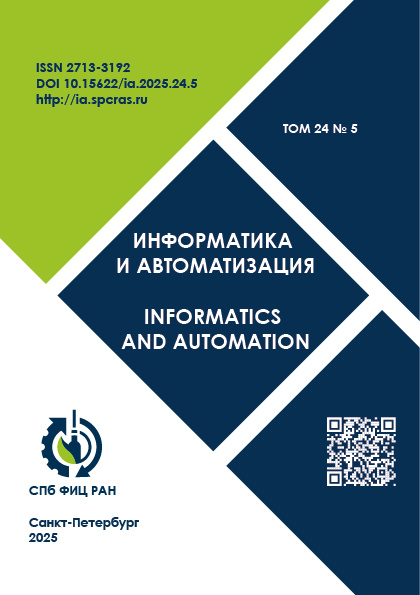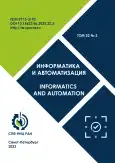Применение многоуровневых моделей в задачах классификации и регрессионного анализа
- Авторы: Лебедев И.С1
-
Учреждения:
- Санкт-Петербургский Федеральный исследовательский центр Российской академии наук (СПб ФИЦ РАН)
- Выпуск: Том 22, № 3 (2023)
- Страницы: 487-510
- Раздел: Искусственный интеллект, инженерия данных и знаний
- URL: https://journal-vniispk.ru/2713-3192/article/view/265810
- DOI: https://doi.org/10.15622/ia.22.3.1
- ID: 265810
Цитировать
Полный текст
Аннотация
Ключевые слова
Об авторах
И. С Лебедев
Санкт-Петербургский Федеральный исследовательский центр Российской академии наук (СПб ФИЦ РАН)
Email: isl_box@mail.ru
14 линия В.О. 39
Список литературы
- Pouyanfar S., Sadiq S., Yan Y., Tian H., Tao Y., Reyes M.P., Shyu M.L., Chen S.C., Iyengar S.S. A survey on deep learning: algorithms, techniques, and applications // ACM Computing Surveys. 2019. vol. 51. no. 5. pp. 1–36.
- Blyth C.R. On Simpson’s Paradox and the Sure-Thing Principle // Journal of the American Statistical Association. 1972. vol. 67. pp. 364–387.
- McConnell S., Skillicorn D.B. Building predictors from vertically distributed data // Proceedings of the 2004 Conference of the Centre for Advanced Studies on Collaborative Research (CASCON ’04). 2004. pp. 150–162.
- Trevizan B., Chamby-Diaz J., Bazzan A.L.C., Recamonde-Mendoza M. A comparative evaluation of aggregation methods for machine learning over vertically partitioned data // Expert Systems with Applications. 2020. vol. 152. pp. 113–126.
- Li Y., Jiang Z.L., Yao L. et al. Outsourced privacy-preserving C4.5 decision tree algorithm over horizontally and vertically partitioned dataset among multiple parties // Cluster Computation. 2019. vol. 22. no. 1. pp.1581–1593.
- Mendoza M.R., Bazzan A.L.C. On the Ensemble Prediction of Gene Regulatory Networks: a Comparative Study // Proceedings of the Brazilian Symposium on Neural Networks. 2012. pp. 55–60.
- Chan P.K., Stolfo S.J. On the Accuracy of Meta-learning for Scalable Data Mining // Journal of Intelligent Information Systems. 1997. no. 8. pp. 5–28.
- Sun L., Mu W.S., Qi B. et al. A new privacy-preserving proximal support vector machine for classification of vertically partitioned data // International journal of machine learning and cybernetics. 2015. vol. 3. no. 6. pp. 109–118.
- Zhou Z.-H., Feng J. Deep forest // National Science Review. 2019. vol. 6. no. 1. pp. 74–86.
- Ho T.K. The random space method for constructing decision forests // IEEE Transactions on Pattern Analysis and Machine Intelligence. 1998. vol. 20. no. 8. pp. 832–844.
- Takacs A., Toledano-Ayala M., Dominguez-Gonzalez A., Pastrana-Palma A., Velazquez D.T., Ramos J.M., Rivas-Araiza A.E. Descriptor generation and optimization for a specific outdoor environment // IEEE Access. 2020. vol. 8. pp. 2169–3536.
- Liu J., Li Y., Song S., Xing J., Lan C., Zeng W. Multi-modality multi-task recurrent neural network for online action detection // IEEE Transactions on Circuits and Systems for Video Technology. 2018. vol. 29. no. 9. pp. 2667–2682.
- Salehi H., Burgueno R. Emerging artificial intelligence methods in structural engineering // Engineering Structures. 2018. no. 171. pp. 170–189.
- Lu J., Liu A., Dong F., Gu F., Gama J., Zhang G. Learning under concept drift: a review // IEEE Transactions on Knowledge and Data Engineering. 2019. vol. 31. no. 12. pp. 2346–2363.
- Zhang X., Wang M. Weighted Random Forest Algorithm Based on Bayesian Algorithm // Journal of Physics: Conference Series. 2021. vol. 1924. pp. 1–6.
- Scanagatta M., Salmeron A., Stella F. A survey on Bayesian network structure learning from data // Progress in Artificial Intelligence. 2019. no. 8, pp. 425–439.
- Wright M., Dankowski T., Ziegler A. Unbiased split variable selection for random survival forests using maximally selected rank statistics // Statistics in Medicine. 2017. vol. 36. no. 8. pp. 1272–1284.
- Zheng X., Aragam B., Ravikumar P., Xing E. DAGs with no tears: Continuous optimization for structure learning // Advances in Neural Information Processing Systems. 2018. vol. 43. pp. 9492–9503.
- Di Franco G., Santurro M. Machine learning, artificial neural networks and social research // Qual Quant. 2021. no. 5. pp. 1007–1025.
- Scanagatta M., Corani G., Zaffalon M., Yoo J., Kang U. Efficient learning of bounded-treewidth Bayesian networks from complete and incomplete data sets // International Journal of Approximate Reasoning. 2019. vol. 95. pp. 152–166.
- Kheyreddine D., Kadda B.-B., Abdenour A. A new adaptive sampling algorithm for big data classification // Journal of Computational Science. 2022. vol. 61. pp. 101–116.
- Лебедев И.С. Сегментирование множества данных с учетом информации воздействующих факторов // Информационно-управляющие системы. 2021. № 3. C. 29–38.
- Лебедев И.С. Адаптивное применение моделей машинного обучения на отдельных сегментах выборки в задачах регрессии и классификации // Информационно-управляющие системы. 2022. № 3. C. 20–30.
- Power Supply dataset. URL: http://www.cse.fau.edu/~xqzhu/stream.html (Дата обращения 27.10.2022).
- Energy generation dataset. URL: https://www.kaggle.com/nicholasjhana/energy-consumption-generation-prices-and-weather/data?select=energy_dataset.csv (Дата обращения 27.10.2022).
Дополнительные файлы










